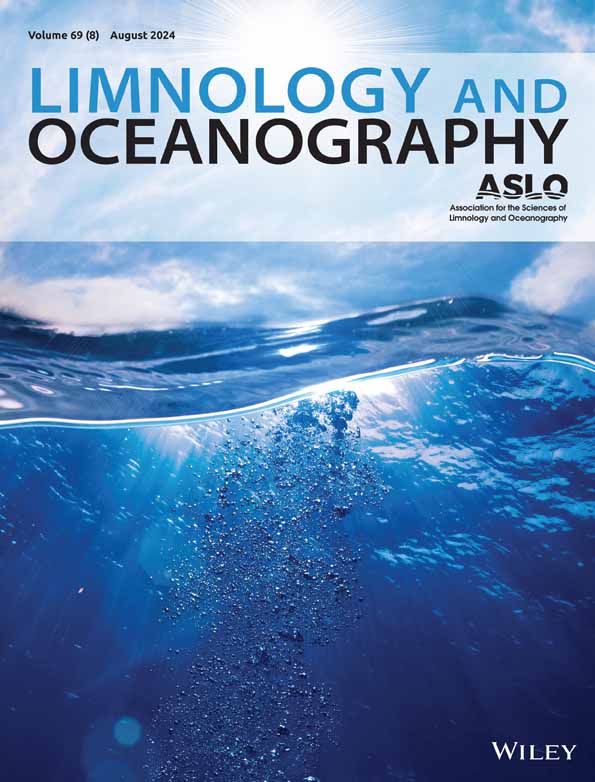在高度受人类影响的平原河网中,城市化通过减少大型无脊椎动物的多样性来改变河流的多功能性
IF 3.7
1区 地球科学
Q1 LIMNOLOGY
引用次数: 0
摘要
城市化通过广泛的土地利用变化、栖息地破碎化和物种组成的改变,极大地破坏了关键生态系统功能的稳定。然而,城市化影响河流生态系统多功能性(EMF)的机制——多种生态系统功能的同时表现——在很大程度上仍然未知。本研究利用长江三角洲(30°47′n - 32°02′n, 119°55′e - 121°20′e) 83个采样点的大型无脊椎动物群落数据,评估了城市化对电磁场的影响。研究了城市化改变生态系统多功能性的途径,包括:(1)生物(如生物多样性)和非生物(如水质)途径;(2)分类多样性和功能多样性;(3)稀有物种与常见物种的比较。偏最小二乘路径模型显示,城市化通过生物(大型无脊椎动物生物多样性)和非生物(总溶解固体、盐度和电导率)两种途径对EMF产生负面影响,其中前者起主导作用。分类多样性比功能多样性更能预测EMF。分类多样性与消费生物量和光合有效辐射呈正相关,与养分浓度呈负相关。我们进一步发现稀有物种比普通物种在维持EMF方面的作用更强。本研究填补了对城市化背景下平原河网河流生态系统多功能性机理认识的空白,并为城市可持续发展策略提供参考。建议城市地区的保护工作应优先保护大型无脊椎动物的分类多样性和珍稀物种。本文章由计算机程序翻译,如有差异,请以英文原文为准。
Urbanization alters river multifunctionality by reducing macroinvertebrate diversity in highly human‐impacted plain river networks
Urbanization has dramatically destabilized crucial ecosystem functions through extensive land‐use changes, habitat fragmentation, and modified species compositions. However, the mechanisms through which urbanization affects river ecosystem multifunctionality (EMF)—the simultaneous performance of multiple ecosystem functions—remain largely unknown. This study evaluated the impact of urbanization on EMF using macroinvertebrate community data collected from 83 sampling sites across the Yangtze River Delta, China (30°47′N–32°02′N, 119°55′E–121°20′E). We investigated the pathways by which urbanization change ecosystem multifunctionality, including: (1) biotic (such as biodiversity) and abiotic (such as water quality) pathways, (2) taxonomic diversity and functional diversity, and (3) rare species compared to common species. Partial Least Squares Path Modeling revealed that urbanization negatively impacted EMF through both biotic (macroinvertebrate biodiversity) and abiotic (total dissolved solids, salinity, and conductivity) pathways, with the former playing a dominant role. Taxonomic diversity emerged as a stronger positive predictor of EMF than functional diversity. Moreover, the taxonomic diversity was positively correlated with consumer biomass and photosynthetically active radiation and negatively with nutrient concentration. We further showed stronger effects of rare than common species in maintaining EMF. Our study fills a gap in the mechanistic understanding of river ecosystem multifunctionality in plain river networks under urbanization and informs strategies for sustainable urban development. We recommend that conservation efforts in urban areas should prioritize the protection of taxonomic diversity and rare species of macroinvertebrates.
求助全文
通过发布文献求助,成功后即可免费获取论文全文。
去求助
来源期刊

Limnology and Oceanography
地学-海洋学
CiteScore
8.80
自引率
6.70%
发文量
254
审稿时长
3 months
期刊介绍:
Limnology and Oceanography (L&O; print ISSN 0024-3590, online ISSN 1939-5590) publishes original articles, including scholarly reviews, about all aspects of limnology and oceanography. The journal''s unifying theme is the understanding of aquatic systems. Submissions are judged on the originality of their data, interpretations, and ideas, and on the degree to which they can be generalized beyond the particular aquatic system examined. Laboratory and modeling studies must demonstrate relevance to field environments; typically this means that they are bolstered by substantial "real-world" data. Few purely theoretical or purely empirical papers are accepted for review.
 求助内容:
求助内容: 应助结果提醒方式:
应助结果提醒方式:


